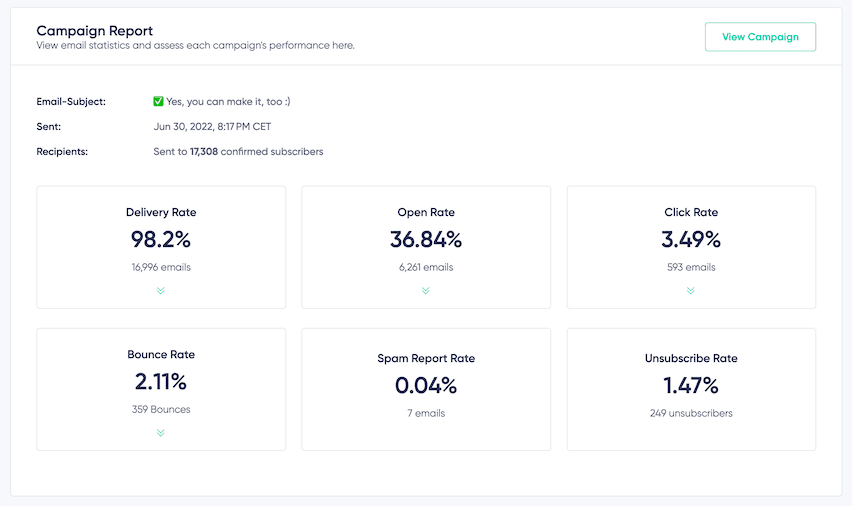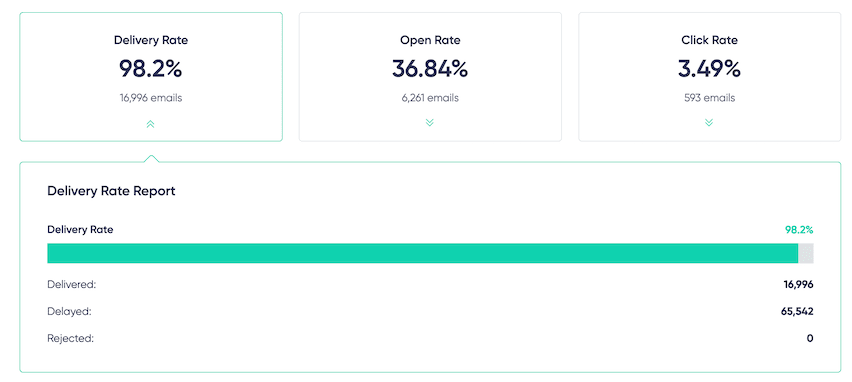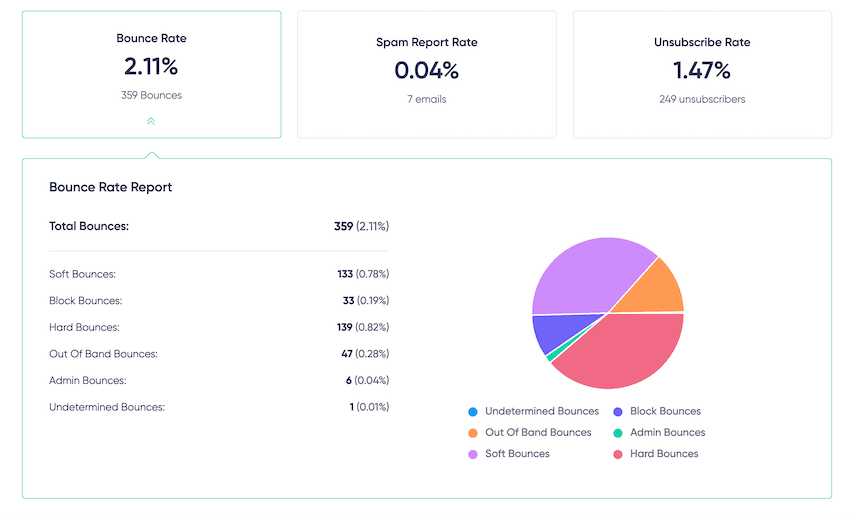Contents
the email tool that makes email marketing simple
Essential Email Marketing Campaign KPIs for Business Growth
Published: December 23, 2024
Introduction to Email Marketing and KPIs
Email marketing, driven by the strategic use of email marketing campaign KPIs, continues to be a vital strategy for connecting with customers and promoting products or services effectively.
This approach offers a direct and personalized channel to engage audiences, firmly establishing it as a vital tool in a business's marketing arsenal.
The foundation of a successful campaign lies in the understanding and leveraging of Key Performance Indicators (KPIs). These metrics are more than just numbers; they are crucial indicators of the health and efficacy of your email marketing efforts.
KPIs in email marketing go beyond mere data points; they provide deep insights into how recipients interact with your emails, what motivates their engagement, and identify opportunities for improvement. Grasping these nuances is vital for refining strategies and ensuring that each email aligns with and contributes to the broader campaign goals.
Developing a robust email strategy involves more than just sending out messages. You need to align the mails with broader email marketing goals.
When effectively utilized to make informed and impactful decisions, KPIs can enhance content engagement, target campaigns more accurately, and ultimately lead to a greater return on investment.
Our exploration will delve into the important role that KPIs, including unique clicks, play in sculpting email strategies. We unravel how these metrics can inform and fine-tune marketing approaches, ensuring that messages reach the audience, resonate with them, and drive them towards the desired outcomes.
Comprehensive Overview of Email Marketing Campaign KPIs
Email marketing thrives on the insightful use of Key Performance Indicators (KPIs), each serving as a critical measure of campaign success. These figures, along with other essential email marketing metrics, provide a multifaceted view of how campaigns perform and interact with audiences.
Let's delve into the most impactful KPIs: open rate, conversion rate, hard bounce rate, unsubscribe rate, and click-through rate, and explore how they collectively shape the trajectory of email marketing campaigns..
Open rate
It's a crucial metric indicating how many recipients open an email, serving as a measure of your subject lines' effectiveness and your brand's image.
A high open rate implies that your emails resonate well with the audience. Improving this rate requires crafting subject lines that are personalized and captivating, designed to grab attention and prompt readers to open the email.
Conversion rate
This KPI goes a step further, indicating the percentage of recipients who perform a desired action after opening an email. This action could be anything from completing a purchase to signing up for more information.
Elevating the conversion rate hinges on delivering content that is engaging and aligned with clear and compelling calls-to-action.
Bounce rate
This tracks emails that fail to reach their intended inboxes. A high email bounce rate can signal issues like outdated email lists or deliverability problems.
Regularly cleaning and updating your list, including removing invalid email addresses, can help minimize this rate and ensure your messages reach their audience.
Unsubscribe rate
This number offers insight into how many recipients choose to opt-out of your email list after receiving an email. It's a crucial metric for understanding audience content preferences and email frequency tolerance.
Balancing content relevance and sending frequency help to maintain a healthily low unsubscribe rate.
Share rate
This metric tracks how often your emails are shared by recipients. A high rate indicates that your content is so engaging and valuable that readers consider it worth sharing. This helps to expand your reach and enhance brand visibility.
Focusing on creating original, valuable, shareable content can significantly increase this rate.
List growth rate
This is a good sign of the expanding reach of your email marketing efforts. A growing list indicates effective audience acquisition strategies and appealing content.
Strategies to enhance email list growth include offering compelling lead magnets and streamlining the subscription process.
Click-through rate (CTR)
The CTR reveals the effectiveness of your email content in terms of engagement. It's the percentage of recipients who click on a link within the email. A high CTR is indicative of content that successfully encourages audience interaction.
To improve CTR, ensure that your marketing emails contain clear, enticing calls-to-action and content that aligns with your audience's interests.
Conversion rate and click-to-open rate are advanced email marketing KPIs providing deep insights into your campaign's effectiveness. Equally important is the focus on your list growth rate, crucial for long-term success. This involves more than just expanding your email list; you need to nurturing an engaged and responsive audience.
Through regular interaction and implementing email segmentation for tailored content delivery, you can greatly improve the health and responsiveness of your list.
These email marketing KPIs offer a comprehensive view of the strengths and areas for improvement in your email strategies. To fully capitalize on these metrics, the right analytics tools are indispensable. These track email KPIs and provide the insights needed for strategic adjustments and campaign optimization. Let's explore this next.
Leveraging Analytics Tools in Email Marketing
Email marketing analytics tools help to track and understand the effectiveness of email campaigns. They enable marketers to monitor key metrics and calculate email performance indicators, such as "emails delivered" and the "spam complaint rate", providing valuable insights into the reach and reception of their communications.
Tracking email deliverability is a fundamental aspect of email campaign analysis. Analytics tools show the number of emails successfully reaching recipients' inboxes. High delivery rates indicate a healthy list and a strong sender reputation, while low delivery rates might suggest issues like poor list quality or deliverability challenges.
Understanding the spam complaint rate is equally important. This metric reveals the percentage of emails marked as spam by recipients, serving as a direct indicator of how recipients perceive your emails. A high rate of complaints can harm your sender reputation and negatively impact future deliverability. By analyzing this rate, marketers can adjust their content to be more relevant and engaging, reducing the likelihood of emails being marked as spam.
Effective use of these analytics tools is about more than tracking; it's about applying the insights gained to align email marketing efforts with overall business objectives. By continuously refining your strategies based on data insights, you'll create impactful email marketing campaigns.
Next, we will delve into how aligning email strategies with business goals can enhance campaign success.
Aligning Email Marketing Strategies with Business Goals and Making Continuous Improvement
Tailoring strategies to fit the size and goals of a business, especially for solo founders, is essential. Different scales of operations and resources mean that strategies need to be adapted for maximum effectiveness. For smaller businesses, this often means creating targeted campaigns that directly speak to a niche audience, maximizing engagement with limited resources.
Email marketing strategy adaptation
For small businesses, a focused approach on building strong relationships with email subscribers is essential. It directly contributes to subscriber list growth. These businesses can benefit from more personalized, direct communication strategies that big businesses might not typically use. The goal is to make each subscriber feel valued and connected to the brand, enhancing engagement rates and the growth of the subscriber list.
Aligning with business goals
Every email sent should serve a purpose and contribute to the broader goals of the business. Whether it's driving sales, increasing website traffic, or building brand awareness, the strategy should be a reflection of these objectives. Setting clear goals helps in measuring the success and return on investment (ROI) of the campaigns.
Understanding email marketing ROI
Every business needs to understand the ROI from campaigns. This involves firstly looking at the direct sales generated then considering factors like engagement levels, customer retention, and long-term value. Solo founders, in particular, need to be mindful of their spending, making email ROI a vital metric.
Managing acquisition cost
Understanding the cost of acquiring new subscribers and customers through marketing is important for budgeting and strategy refinement. You need to find the balance between spending on acquisition and the value derived from new subscribers.
By focusing on these areas, email marketers can ensure that their campaigns are aligned with their business objectives plus are continuously improving based on campaign performance insights. This ongoing refinement process is essential to achieve long-term success in digital marketing.
Utilizing Maildroppa’s Analytics for Email Marketing Campaign KPIs
Maildroppa's analytics suite provides a clear and intuitive way to explore email campaigns. It focuses on distinct and valuable details for each KPI.
Delivery rate insights
Maildroppa's reports provide deep insights into delivery rates, including details on emails delivered, delayed, and rejected.
Open rate analysis
Maildroppa offers a nuanced analysis of email open rates, distinguishing between unique and total opens. This differentiation is crucial for gauging initial appeal and sustained interest in your emails.
Clickthrough rate insights
The platform provides detailed data on both the Unique Click Rate and Total Click Rate, offering insights into initial engagement and ongoing interaction with your content. This level of detail is critical for refining content and call-to-action strategies.
Detailed bounce rate analysis
Maildroppa excels in its breakdown of bounce rates into categories such as soft bounces, hard bounces, and others. This detailed analysis is vital for diagnosing and addressing email delivery issues and maintaining a healthy email list.
Click-to-open rate evaluation
This metric, indicating how engaging your content is to those who open your emails, helps you evaluate your content relevance and effectiveness, thereby guiding strategic improvements.
Using Maildroppa's analytics, marketers can gain valuable insights into how their emails are received and interacted with, enabling them to make specific changes that improve key KPIs and the overall effectiveness of their marketing efforts.
In Summary
Key performance indicators are indispensible in enhancing the effectiveness of email campaigns. They provide windows into various aspects of your campaign, such as how many emails are delivered, opened, and interacted with by the audience.
Maildroppa's Email Metrics Dashboard stands out by offering a detailed view of these essential metrics. This tool goes beyond just presenting data; it enables strategic decision-making for refining your email campaigns. With comprehensive reports on delivery rates, open rates, click-through rates, and particularly its in-depth bounce rate analysis, Maildroppa offers unique insights into how your emails are performing.
This powerful analysis helps in aligning your strategy with your business goals, driving growth, and enhancing customer engagement. For anyone looking to upgrade their marketing strategy, Maildroppa offers a solution.



